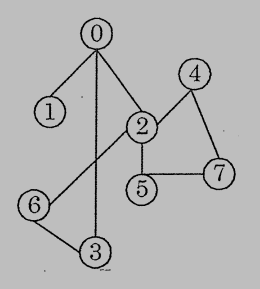一、Data Structures (50%)
1. Answer True or False for the following statements. Give correct answer or explain clearly for False statements. (12%)
(1) Let G be a graph with e edges and v vertices. If G is represented by adjacency matrix, DFS requires O(e2) time.
(2) The path from vertex u to vertex v on a minimal cost spanning tree of an undirected graph G is also a shortest path from u to v.
(3) In static hashing, the worst-case number of comparisons needed for a successful search is O(n) for open addressing. The number could be reduced to O(logn) by using chaining method.
參考解答:(1) F (2) F (3) F
2. Consider the following AOE network: (18%)

(1) Obtain e(i) and l(i) for all activity i.
(2) List all critical activities.
(3) List all critical paths.
參考解答:
(1)

(2) a1,a3,a4,a6,a8,a9,a11.
(3) v0→v1→v4→v7→v8 v0→v3→v5→v7→v8
3. Given the following 8 runs: (20%)

(1) Draw the corresponding winner tree.
(2) Draw the restructured winner tree after one record has been output.
(3) Draw the loser tree based on the answer of question (2).
(4) Derive the total required time to merge n records through a winner tree with k runs.
參考解答:
(1)

(2)

(3)

(4) Θ(nlgk)
二、Algorithms (50%)
1. (10%) How can we prove the given problem in NP-complete?
參考解答:
(1) Verify that the problem has a non-deterministic algorithm in polynomial time.
(2) Reduce a known NPC problem to the given problem.
2. (10%) Give an algorithm that determines whether or not a given undirected graph G=(V,E) contains a cycle. Your algorithm should run in O(V) time, independent of |E|.
參考解答:
(1) Input G(V,E), 令 S 為 source.
(2) If |E|≥|V|, 則 return “cycle found”.
(3) Else enqueue(S), declare empty set S={}.
(4) Dequeue(S), ∀u∈adjList(v) 若 u∈S, 則 return “cycle found”, else S=S∪{v}.
3. (10%) True or false, please explain your answer.
(a) 0-1 knapsack problem can be solved by greedy strategy.
(b) In an undirected graph, we can apply the Depth-First-Search algorithm (DFS) to get tree edges and cross edges.
(c) Based on the top-down approach, we can use the memorization to reduce the time.
(d) Unweighted longest simple path problem has the optimal sub-structure.
(e) If we first apply the topology sort to a directed graph and then run the DFS algorithm on this graph, no back edges can be obtained.
參考解答:(a) F (b) F (c) F (d) F (e) T
4. (10%) Use Master theorem to solve the recurrence T(n)=T(2n/3)+1.
參考解答:Θ(logn)
5. (10%) Write the breadth first spanning tree staring at node 0 (visit the smaller number first).

參考解答:

試題(pdf):連結
有任何問題,或想要完整解釋的,歡迎在下方留言唷!





Jackson
您好,請問如果 (2) 寫用 DFS find back edge 可以嗎 ?
https://stackoverflow.com/questions/526331/cycles-in-an-undirected-graph
還有想問 3 (b) 錯的原因 ? 感恩
mt
第二題可以用DFS喔~
3(b)錯在cross edges,一個undirected graph只會有tree edge跟back edge。
michael
想要請問一下第3題的(c)小題,以算fibonacci的第n個數為例:
val[1, 2, …., n] = [0, 0, …, 0]
val[1] = 1
val[2] = 1
fib(int n) :
if val[n] != 0:
return val[n]
else
return val[n] = fib(n – 1) + fib(n -2)
這樣的話是否應該算是在top-down的過程中透過val array進行memoization來reduce time呢
mt
對!這題應該是true才對,感謝~
bill
可是他題目是memorization而不是memoization
mt
對誒!沒注意到,就是錯這裡沒錯,感謝!